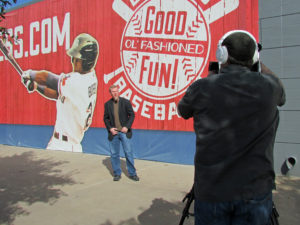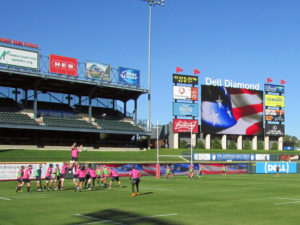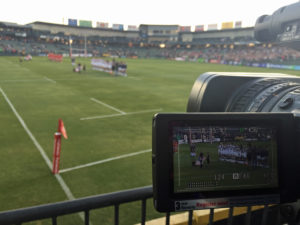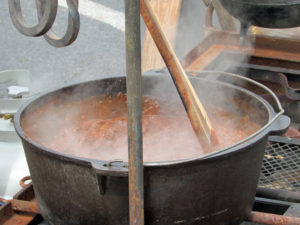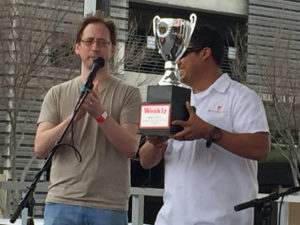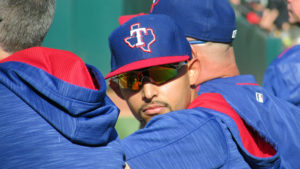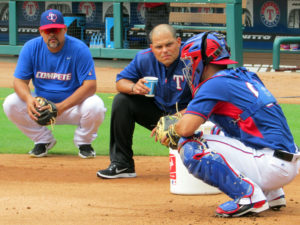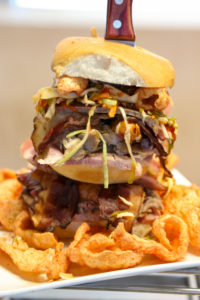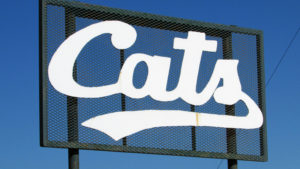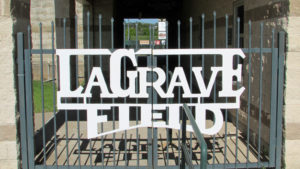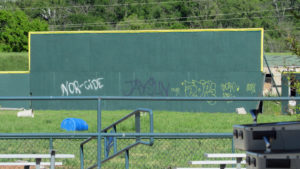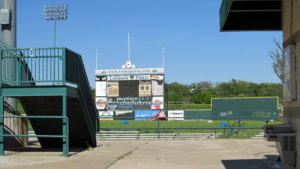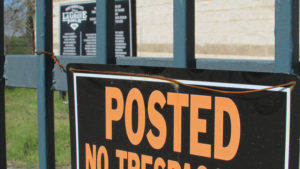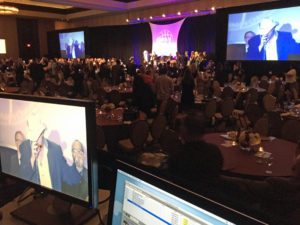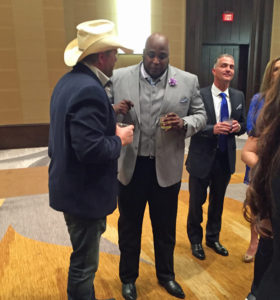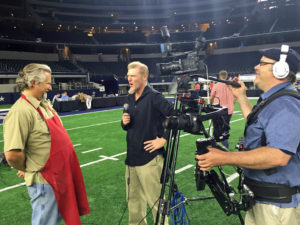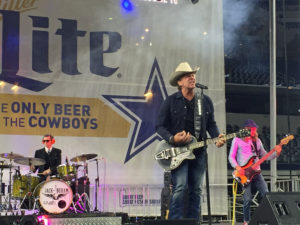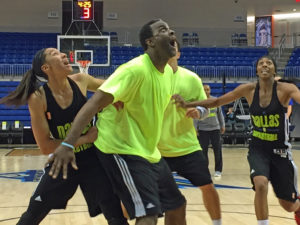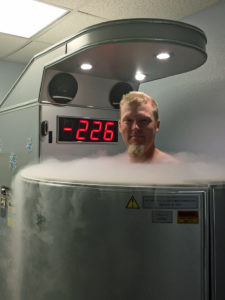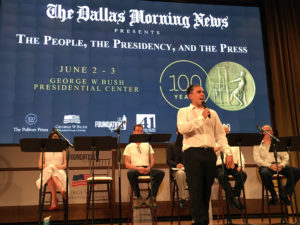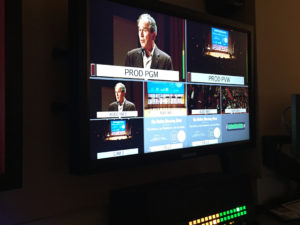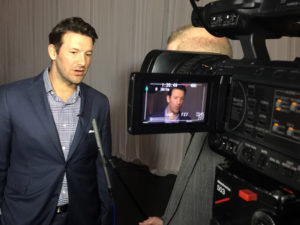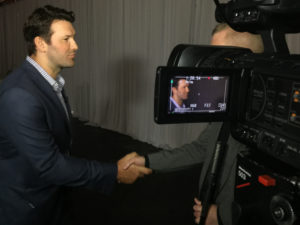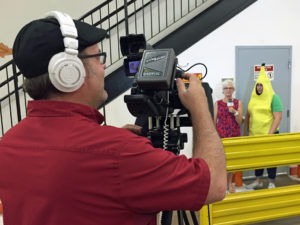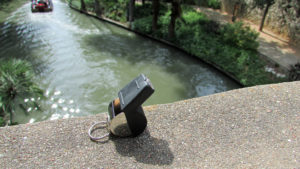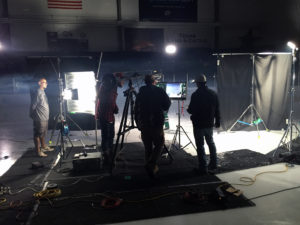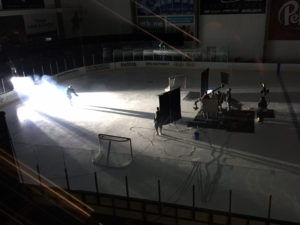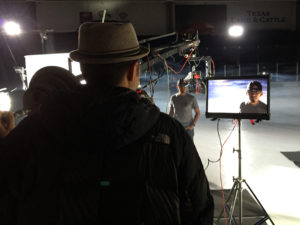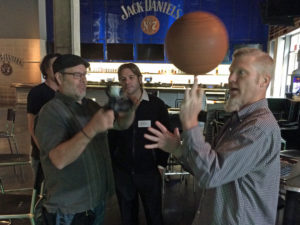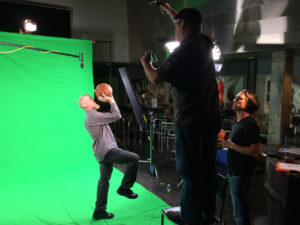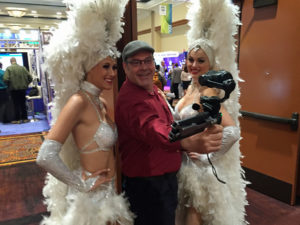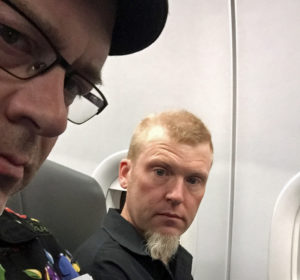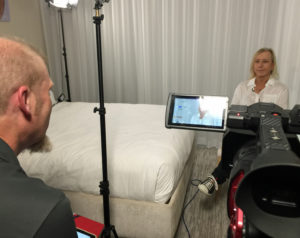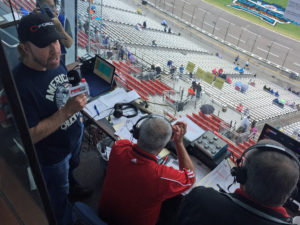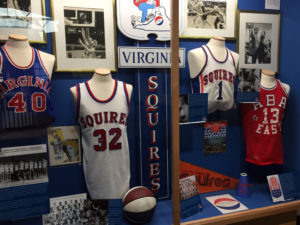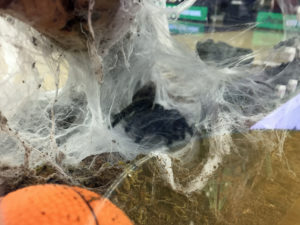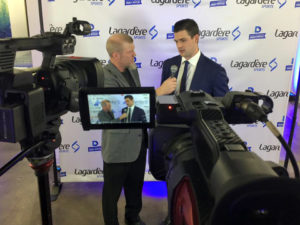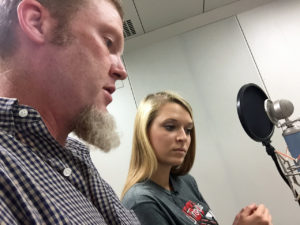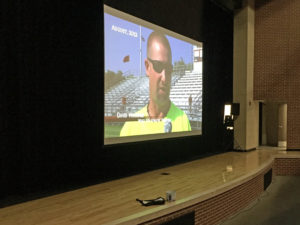This post originally appeared at the Fort Worth Weekly's website. To view it there :
https://www.fwweekly.com/2016/11/09/racing-on-the-radio/
“Let’s go trackside and get it all started here in Texas.”
Now that Doug Rice had made the call, it should have been time for
racers to start their engines. But instead of beginning Sunday’s AAA
Texas 500, a crucial race in the NASCAR season, 40 cars sat on pit road
under car covers. A brief rain shower had made the track too wet to
race, and the Texas humidity made drying it, even with jet dryers, a
challenge.
Texas Motor Speedway hosts two races each year, in April and
November, in the highest tier of stock car racing, NASCAR’s Sprint Cup
Series. Drivers once competed in automobiles you could buy at a
dealership, though today’s high-performance racing vehicles only loosely
resemble the Fords, Chevys, or Toyotas a fan might drive to the track.
From humble roots in the South, NASCAR has become America’s most popular
motor sport, with a season running from February’s iconic Daytona 500
to the season championship in Homestead, Fla., the weekend after next.
In that final race, the National Association for Stock Car Auto Racing
will declare the fastest of four pre-determined drivers the overall
winner for 2016. In a playoff system called the “Chase for the Sprint
Cup,” it has culled its highest-ranked drivers down to a final eight,
and any of those who win one of the three races immediately preceding
the Homestead event, including the one at TMS, would automatically
qualify as one of those last four drivers with a chance to win the whole
thing. And even for drivers not in the Chase, winning a race is huge.
Thus
drivers and their support personnel waited anxiously for the track to
dry, as did thousands of fans at TMS. In addition, a crew of 18
headset-wearing NASCAR enthusiasts was preparing to embark on its own
marathon of sorts.
*****
They were the men and women of the
Performance Racing Network, a
company for which Rice has worked since 1988. PRN’s president and lead
announcer also told me during the stoppage that he has learned to not
let the weather bother him, because it’s all part of the gig.
PRN understands racing’s nuances. The company has been in business
since 1981. It’s a property of Speedway Motorsports, Inc., the same
group that owns Texas Motor Speedway.
The only other major radio network that covers all NASCAR Sprint Cup
racing is Motor Racing Network. The Daytona Beach-based International
Speedway Corporation owns MRN, as well as racetracks where NASCAR holds
19 of its 36 Sprint Cup races. They cover all the races held at those
tracks, plus those at Dover and Pocono. PRN handles lap-by-lap coverage
for the dozen races staged at SMI’s tracks and partners with the IndyCar
Radio Network for the Brickyard 400. The Indianapolis Motor Speedway,
site of the Verizon IndyCar Series racing circuit’s Indianapolis 500,
hosts the Brickyard 400. Individual tracks can choose their radio
broadcasters, though NASCAR controls all television rights.
Based in North Carolina at Charlotte Motor Speedway, PRN produces a
number of NASCAR-themed radio talk shows as well, though Rice noted,
“The main crux of what we do is cover live Sprint Cup and live Xfinity
[Series] racing.”
Fans can listen to their productions on a number of outlets,
including local affiliate radio stations, satellite radio, online, and
at the track over a dedicated frequency on the scanners that fans can
rent or buy at the race.
*****
Every time I’ve listened to a stock car race on the radio, I’ve come away amazed.
One announcer talks, then another, and then a third and a fourth.
Each picks up where the other left off, somehow keeping up with cars
traveling close to 200 miles per hour without interrupting a colleague.
Then a wreck happens, and suddenly they’re narrating that chaos, and
minutes later they’re talking to the driver whose race has ended. It all
sounds so smooth to your ears and mine, but I know, behind the scenes,
it can’t be.
Having worked in a lot of TV trucks covering sporting events with
multiple cameras, I’ve seen how hectic it can get keeping up with a pair
of teams playing with two or three announcers describing the action. So
I always wanted to know how a crew could possibly manage a broadcast
involving 40 teams on a mile-and-a-half playing surface with a half
dozen or more commentators –– and all without the benefit of pictures.
The PRN folks, said NASCAR veteran Jeff Burton, who won 21 top-level
races before moving into television, “have a passion for what they do,
and they put a lot of work into making sure they bring what’s going on
on the racetrack to the fan that’s not able to see it.”
PRN’s people spend their lives, and a lot of weekends, away from
home, immersed in racing because, as PRN pit reporter Brad Gillie put
it, they “live and breathe the sport.”
In some ways, they have a dream gig, one that millions of fans who
religiously follow drivers like Burton no doubt envy. That doesn’t mean
it’s an easy job. NASCAR’s complicated nature makes up part of the
circuit’s appeal.
“Before the race ever starts,” Rice said Friday, “myself and
whoever’s co-anchoring, we decide who’s calling the last lap. That way,
there’s no scramble.”
After the green flag waves to begin the race, fans listening on their
preferred device hear a succession of voices describing the action.
Listeners might wonder how each broadcaster knows when to talk. It turns
out they rely on some standard progressions as they follow the field of
cars. Rice calls the action on the track’s frontstretch before turn
announcer Rob Albright takes over.
“When I stop, Rob automatically knows to pick them up, and about turn
one he will take them into turn two, halfway down the backstretch, and
when he stops talking, Pat Patterson knows. He picks up the baton and
takes it back to turn four, and [co-anchor] Mark [Garrow] and I
alternate laps. That way, while one of us is talking, the other one can
be looking up something or attending to other details. So that’s like a
relay race.”
An automobile race never consists of one smooth sequence. Sometimes
the focus must change from the cars circling the track to other areas of
interest. Rice takes cues from a colleague in the booth.
“The director is the one that’s telling us when to go downstairs, which pit reporter to talk to.”
Wally Leavitt, who served as Sunday’s director, said, “I will keep
track of the pit reporters primarily and who has who. If we got green
flag or yellow flag pit stops, I will have to make sure that we get the
throw down to them.”
“Let’s go down to Brad Gillie.” –– Doug Rice, cueing his pit reporter
“There’s four of us on pit road, and we basically divide up pit road
into quarters,” Gillie explained. “We’re down there telling the story
behind the curtain. Because in our sport, we’re unique in that we do get
to be in the huddle. We do get to hear the strategy as it’s playing
out.”
In painting the picture of whether or not those strategies succeed, the broadcasters don’t have actual pictures to help them.
“All we have is our voice,” Rice said. “It’s not like television. There is no ‘Ready [camera] one, take one.’ It goes off feel.”
“Watching up front
now, Kevin Harvick starting to close the distance here to the leader.” –
Pat Patterson, tracking the No. 4 car’s progress
In a television truck, a director bears the responsibility for
choosing what goes on the air next. While scanning multiple camera
monitors does require a great deal of skill, the TV director can use his
eyes as well as his ears to select his next source. A radio director or
on-air presenter can only listen. Every person on the crew must master
the art of mentally processing multiple audio streams simultaneously.
“In my ear, I’m listening to the scanner and listening to their
in-car communication,” Gillie said of the device he uses to hear what
the drivers and pit crews say to one another during a race. “I’m
scanning the drivers in my section of pit road that are relevant.”
“Kyle Busch wanted to come in much, much sooner.” – Brad Gillie, reporting what he had learned about a pit stop
“If I know there might be a developing story, I might lock it on a
particular driver or something like that,” Gillie said. “If I have the
race leader, I might spend more time listening to that channel.”
*****
Gillie also has to listen to his director and to what’s actually
going out over the air, in case one of his on-air colleagues suddenly
pitches to him.
Rice has to talk while monitoring three audio feeds, including the official race communication channel.
“In the booth,” he said, “I hear the director. I hear ‘program’ ––
what’s going on the air –– and I monitor NASCAR. Their channel is in my
ear, and I can hear everything the race director is saying. Mainly what
I’m listening for are keys to a caution. He’ll say, ‘Debris, turn two’
and put out the yellow [caution] flag. So you kind of condition yourself
to not hear all the other chatter, but I hear that, and I hear
penalties.”
“He made two pit stops as the lucky dog car. That’s penalized him and cost him a lap.” – Doug Rice, explaining a Kurt Busch mishap
Leavitt, who normally works for the IndyCar Radio Network but filled
in with PRN at the races in Charlotte and Fort Worth, listens to all
those sources plus the engineers.
“The hardest part is to make sure that you are listening to the
person you really need to listen to, because everybody’s talking at
once, and you need to make sure that you’re listening to the one source
that you want to know the information from.”
Making sure all those sounds get to all those ears means an extensive
technical operation under supervision of PRN lead engineer Harrill
Hamrick, who mixes the show from a truck near the garages. In Fort Worth
on Sunday, no technology could remedy one of a sports broadcaster’s
most untenable situations.
“Weather always adds a huge unknown X factor to this,” Rice said.
“If weather comes in, it’s going to finish this race and for Carl Edwards, it could be Christmas come early.” –– Mark Garrow, after an exemplary pit stop gave Edwards the lead
*****
During Sunday’s delay, Rice and his colleagues stayed on the air long
enough to explain the situation to the audience and to speak to a
special booth guest: Chuck Norris.
The former
Walker, Texas Ranger star had come to the track
to announce the names of the eight Chase drivers. He helped PRN fill
time by talking about Chuck Norris facts. He likes them and finds them
funny.
“Chuck Norris eats
bullets for breakfast. Watch out when he burps.” – Norris, on the
“Chuck Norris fact” that his 10-year old son suggested
The speedway displayed a variation on the meme on their Big Hoss
video board, a mockup of Norris kicking Michael McDowell’s car into a
wreck. When a real mishap occurs on the track, the normally jocular
announcers treat it as nothing to laugh about.
“After he made the pit stop, one of the tires that came off the
car blew right after they brought it over the wall, back into the pit.
It blew right in the face of tire specialist Mason Jennings. His ears
are ringing. The doctors came in and looked at it. They have taken him
to the infield care center.” ––
pit reporter Jim Noble describing an accident involving Paul Menard’s crew
“In the event of an accident,” Rice said, “we never, never, never
speculate about a driver being injured. That’s why we have reporters
that go to the infield care center, and somebody will be there. If
there’s a serious injury, somebody’s going to come out and talk. I mean,
I don’t care what the circumstances are. I don’t care what our turn
announcers or pit reporters can see. You’re not a medical doc. Don’t
speculate on it. Let somebody else do that.”
PRN’s veteran broadcasters know auto racing’s protocols. Still, a
reporter like Gillie must often approach a driver during testy times,
such as after a mechanical issue has forced his or her ride off the
track.
“If the car goes to the garage, and it’s a part of the story of the
race – because that’s our job is to tell the story of the race – then
we’ll go down there, and it might be, ‘Hey, I’ve got a report from the
garage. Here’s what happened to the car. They broke this.’ It might be
I’ve got a report, and then five minutes later, I’ve got the driver
because they’re out of the car, and we interview them.”
As official race broadcasters, PRN personnel have clearance to speak
to drivers even as the race continues around them. Tone and approach
become crucial to turning access into information.
“You’ve got to get the answer that you’re looking for, but the way
you present the question might make all the difference in the world,”
Gillie said. “I don’t think you want to go out there and just say, ‘You
know, man, it looks like what you did was pretty stupid.’ ”
“Austin, would you call that a racing incident?” –– pit reporter Steve Richards after Austin Dillon’s car got knocked out of the race
Drivers understand broadcasters must cover the tough parts as well as the victories.
“They get it,” Gillie said. “Most all these drivers are wonderful about doing that.”
Burton believes the unique nature of motorsports helps foster
collegiality between the contestants and those who cover them regularly.
“I think what makes our sport really, really special is that
contact,” Burton said. “Think about the NFL. They’re with different
broadcast people every week. The local [team] has their own radio
station, but the network changes, as opposed to NASCAR. You’re with the
same people pretty much every week. You’re either with PRN or MRN, or
you’re with Fox or NBC [on the TV side]. And so you get to know
everybody.
“I always viewed the broadcasters,” he continued, “whether it was
radio or TV, when you interacted with them, they were coming to talk to
you to get information to relay it to the fans, and I always viewed the
broadcasters as a conduit to the fans.”
*****
By engaging with reporters, a driver does more than reach out to his
followers. He or she also advances the business side of the sport. A
driver who talks to the media will likely do so wearing clothing bearing
corporate logos. He or she will almost invariably find a way to
verbally namedrop one or more companies who pay for association with the
race team.
“We had a good AAA Fusion capable of winning the race.” – driver Joey Logano in a post-race interview with Brad Gillie
Sponsors pay for the costs of running a race team. And like most
media ventures, advertisers finance the Performance Racing Network.
“Our sales are done internally,” Rice said. “We have a three-person sales staff.”
He sees the audience that his salespeople take to market as pretty well defined.
“Speaking of the
fans, Doug, we constantly say thank you to the NASCAR fans because they
are die-hard.” – Mark Garrow, offering love to rain-soaked spectators
“People that are going to take time out of their day to listen to a
race broadcast, they’re P1s,” Rice said, referring to the radio industry
term for the most loyal listeners to a given outlet. “They know what
they want, and it’s not our job to go out and spread the gospel of
NASCAR. We’re preaching to the converted.”
In Fort Worth, the congregation can find PRN’s work on 95.9-FM The
Ranch, whose bosses signed on this year to carry PRN’s Texas race
broadcasts and tap into its listener base.
“A couple of Toyotas battling for the lead here at Texas Motor Speedway!” –– Doug Rice, excited about a tight contest
The Ranch also believes racing will appeal to its existing listeners.
“There’s synergy with our audience,” said Gerry Schlegel, president
of LKCM Radio Group, which owns The Ranch. “That is a very Texas-centric
audience. We kind of have this wide-open attitude, no-limits kind of
attitude, which reflects very well with the spirit of Texas Motor
Speedway.”
The station also worked a promotional deal with the racetrack that bills itself as “
No Limits, Texas.”
TMS has “put together a great relationship with the Ranch, not just
for the broadcast that PRN does but for a lot of the other stuff that
Texas [Motor Speedway] does as the official radio station,” said Gillie,
who graduated from Euless Trinity High School, lives in Fort Worth, and
formerly worked for the speedway.
One might interpret NASCAR followers’ transfer of loyalty from sport
to sponsor as naïve, an example of less-than-sophisticated thinkers
being influenced by advertising. More likely, it represents a true
understanding by those fans of how such relationships work. Brands want
to cultivate those fans’ loyalty through their sponsorships. By
providing them what they want, fans do their part to ensure the
viability of their favorite drivers and their favorite sport.
Such is the NASCAR culture. As sports fans, and racing fans in
particular, it perhaps reflects a desire to feel a bond with something
beyond the grind of everyday jobs and challenges. We all wear the
shirts, caps, and underwear of our favorite sports teams. Sports radio
broadcasts, perhaps more than any other mass medium, serve much the same
function by allowing us to bring our passions into our spaces, at our
desks, on our commutes.
“I had to bring my
Thanksgiving pants.” –– Doug Rice, during a booth visit by a Miss
Sprint Cup spokeswoman, referencing a dinner Sprint had bought them
*****
With the NASCAR season’s final pair of races at non-SMI tracks, PRN’s
AAA Texas 500 broadcast represented its final one of 2016. However,
they won’t sit idle until February’s Daytona races restart NASCAR’s
calendar.
“We have a big meeting at PRN,” Rice said, “basically outlining the
calendar for next year. What are we going to do better? What are our new
initiatives going to be?”
As much planning as PRN staffers will do in their short offseason,
when the time comes to race again, they will once more find themselves
dealing with situations at the track that nobody expected. In fact, when
it comes to a NASCAR broadcast, the unpredictable parts take top
priority.
“One cardinal rule that we have maybe above all else is live action
on the track supersedes everything,” Rice said, “whether it’s a pit
report or somebody that’s supposed to be interviewed in the booth. If
there’s live action going on on the racetrack, especially a battle for
the lead, that trumps everything else and until that’s settled, Brad’s
pit report, or this person we’ve got to interview, or this story, or
this piece of salesmanship can wait.”
“Trouble in turn four!” –– Pat Patterson, interrupting a sponsored segment to report a wreck
To establish proper priorities, and create the workflows to
accomplish them, one has to understand the essence of one’s business.
It’s a lesson Rice learned at the first running of the Brickyard 400 in
1994 from a pair of seasoned colleagues at the IndyCar Radio Network.
“They’re probably 20, 30 years older than me. And I’d met them the
day before, so they knew who I was. So one of them was sitting there
having coffee, and he looks at me he goes, ‘So what is it you do again?’
“And I said, ‘Well, I’m with Performance Racing Network. We broadcast NASCAR races.’
“He goes, ‘That’s not what you do.’
“And I’m like. ‘Yeah, it is.’
“He said, ‘No, that’s not what you do at all. You’re in the transportation business,’ and I said, ‘What are you talking about?’
“He goes, ‘It’s your job when you’re broadcasting that race to
transport the guy driving down the interstate, or working in his garage,
or out on his bass boat, from where they are to where you are.’ He
said, ‘If you can get that battle won in their head, and they are
mentally at the racetrack with you, that’s what you do. You’re in the
transportation business.’
“I went, ‘OK, you’re right.’ And I think about that every race we do.”
*****
At Sunday’s event, they never got to transport the listener to the
finish line for the waving of the checkered flag. Though the race did
eventually start after a six-hour delay, a second downpour ended the
contest several laps short of the planned 500-mile run. NASCAR officials
informed Carl Edwards he had won as the cars sat idling on pit road.
We’ll never know which announcer would have called the winner across the
finish line.
It’s all part of the unpredictability of sport. This sport, and
bringing it to those who love it, is what PRN is all about. They have,
in fact, found the right business.
“They make magic,” Schlegel said. “These guys are incredible. The
description, it’s very high-energy, super-fast pace. They cut from one
person to the next. They’re describing exactly what they see in front of
them, sparks flying off the fenders. You can hear the engines and the
energy is unlike any other kind of broadcast.
“They really pull you in like you’re at the race. It’s remarkable.”
Rush Olson writes the Fort Worth Weekly’s
sports blog and produces sports content and related endeavors through
his companies Rush Olson Creative & Sports and FourNine Productions.
Read more of his interview with Jeff Burton in this week’s Sports Rush
blog post, found in the Blotch section at fwweekly.com.
RushOlson.com
Linkedin.com/company/rush-olson-creative-&-sports
Facebook.com/RushOlsonCreativeandSports
